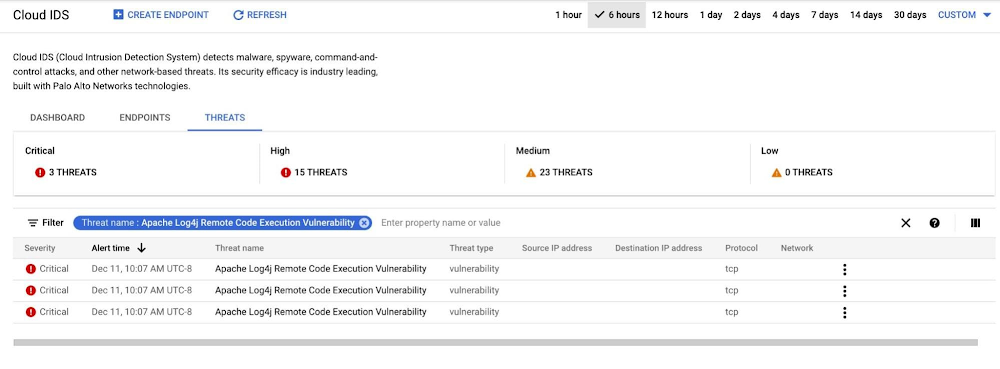NIST has announced a recent vulnerability (CVE-2021-44228) in the Apache Log4jlibrary. To help with detection, Google Cloud IDS customers can now monitor and detect attempted exploits of CVE-2021-44228. BackgroundThe Apache Log4j utility is a commonly used component for logging requests. On December 9, 2021, a vulnerability was reported that could allow a system running Apache Log4j version 2.14.1 or below to be compromised and allow an attacker to execute arbitrary code. On December 10, 2021, NIST published a critical Common Vulnerabilities and Exposure alert, CVE-2021-44228. More specifically, Java Naming Directory Interface (JNDI) features used in configuration, log messages, and parameters do not protect against attacker controlled LDAP and other JNDI related endpoints. An attacker who can control log messages or log message parameters can execute arbitrary code loaded from remote servers when message lookup substitution is enabled.If you have workloads you believe may be vulnerable, you can use Google Cloud IDS to help monitor and detect for exploit attempts in your Google Cloud environment. You can read further details on the NIST website here, and Google Cloud’s security advisory here. Addressing Apache Log4j vulnerability with Google Cloud IDSGoogle Cloud’s Cloud IDS is a native network-based threat detection product that helps detect exploit attempts and evasive techniques at both the network and application layers, including buffer overflows, remote code execution, protocol fragmentation, and obfuscation. The detection capability is built with Palo Alto Networks threat detection technology. To help our customers monitor the Cloud IDS team has worked with Palo Alto Networks, and the Google Cybersecurity Action Team team, to analyze this issue and update the Cloud IDS detection systems to help detect the most common types of Log4j exploit attempts in their GCP environments.For customers currently using Cloud IDS this has been automatically deployed, as of 12-12-2021 at 9:00PM UTC and no further action is required to enable it. Any new deployments or new Cloud IDS endpoints will have this monitoring enabled by default. The alerts from these detections have a severity level of Critical, and so all Cloud IDS endpoints will alert on these detections with no configuration changes required to your IDS endpoint threat severity profile.Monitoring for potential threatsAfter you set up Cloud IDS to monitor traffic to/from application workloads that may be exploited due to this vulnerability you can quickly search for alerts related to CVE-2021-44228 in the Cloud IDS console by using a filter on “Threat Name:Apache Log4j Remote Code Execution Vulnerability”Cloud IDS detections on threats exploiting Apache Log4j vulnerabilityThreat Details for Log4J threats detected by Cloud IDSIn addition to monitoring for Log4j threat alerts in the Cloud IDS console you can also view more detailed logs in Cloud Logging. More details about Cloud IDS logs can be found here.Addressing potential threatsIn addition to updating your systems to the latest version of Apache log4j, customers using Google Cloud Armor can enable a new pre-configured WAF rule to help block requests to vulnerable infrastructure.Complete Cloud IDS product documentation for configuring Cloud IDS and filtering on alerts and logs is available here:Configuring Cloud IDSViewing Cloud IDS LogsPlease contact Google Cloud’s technical support or your Google Cloud account team for assistance if required. Additionally, you can seek support assistance in the Google Cloud Platform Community Slack Channel under gcp-security for non-urgent questions.Related ArticleGoogle Cloud Armor WAF rule to help mitigate CVE-2021-44228 Apache Log4j vulnerabilityCloud Armor WAF rule to help address CVE-2021-44228 Apache Log4j vulnerability.Read Article
Quelle: Google Cloud Platform

Published by